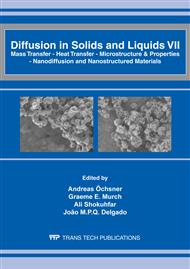p.632
p.641
p.647
p.654
p.662
p.668
p.674
p.682
p.690
Drying Kinetics of External Thermal Insulation Composite Systems (ETICS)
Abstract:
Moisture is one of the most deteriorating factors of buildings. The moisture content depends on hygroscopic equilibrium between buildings materials and environment, which is determined by the drying and wetting rate of masonry. So, the moisture content is not only determined by the water that is absorbed by the material, but also by the amount of water that is evaporated under favourable conditions, which is described by the drying process. In this work we analyse the drying kinetics of External Thermal Insulation Composite Systems (ETICS) using a first-order and a second-order drying kinetic models to describe mass transfer phenomenon. The results show that the second-order kinetic models described well the drying process studied. The application of kinetics models to the experimental results was explored and several parameters were retrieved. A proposal for the use of these parameters is presented and its practical use is discussed.
Info:
Periodical:
Pages:
662-667
Citation:
Online since:
April 2012
Authors:
Keywords:
Price:
Сopyright:
© 2012 Trans Tech Publications Ltd. All Rights Reserved
Share:
Citation:


